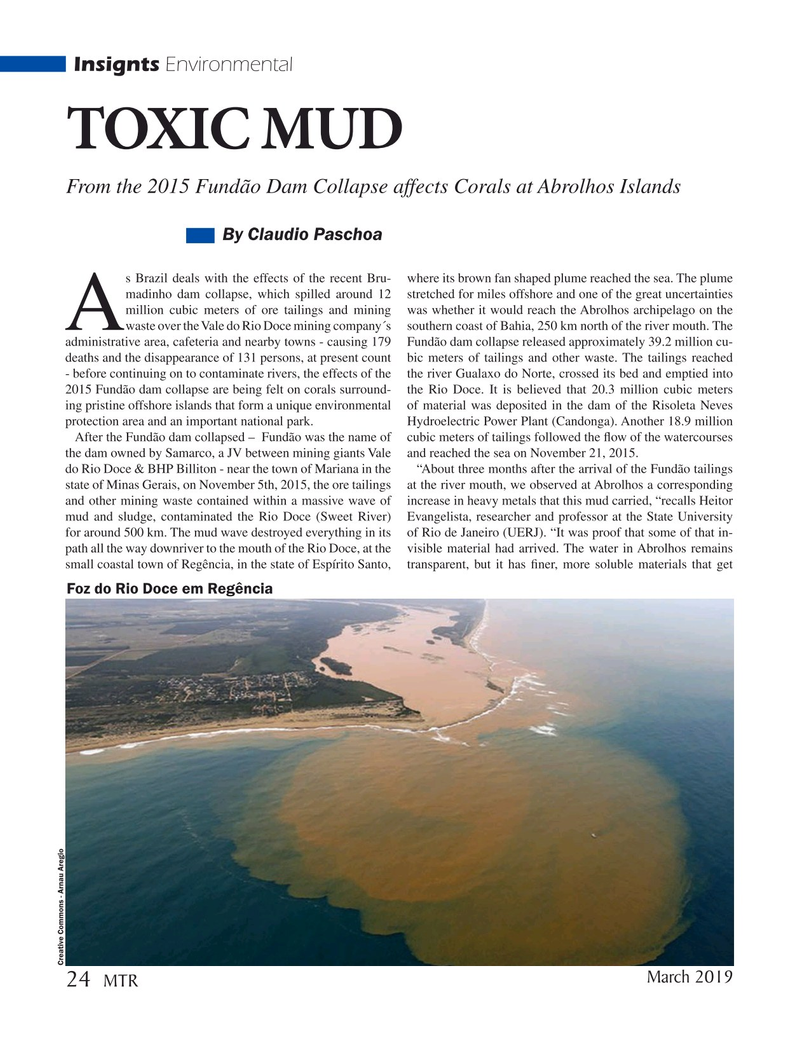
Page 24: of Marine Technology Magazine (March 2019)
Oceanographic Instrumentation: Measurement, Process & Analysis
Read this page in Pdf, Flash or Html5 edition of March 2019 Marine Technology Magazine
Insignts Environmental
TOXIC MUD
From the 2015 Fundão Dam Collapse affects Corals at Abrolhos Islands
By Claudio Paschoa s Brazil deals with the effects of the recent Bru- where its brown fan shaped plume reached the sea. The plume madinho dam collapse, which spilled around 12 stretched for miles offshore and one of the great uncertainties million cubic meters of ore tailings and mining was whether it would reach the Abrolhos archipelago on the
Awaste over the Vale do Rio Doce mining company´s southern coast of Bahia, 250 km north of the river mouth. The administrative area, cafeteria and nearby towns - causing 179 Fundão dam collapse released approximately 39.2 million cu- deaths and the disappearance of 131 persons, at present count bic meters of tailings and other waste. The tailings reached - before continuing on to contaminate rivers, the effects of the the river Gualaxo do Norte, crossed its bed and emptied into 2015 Fundão dam collapse are being felt on corals surround- the Rio Doce. It is believed that 20.3 million cubic meters ing pristine offshore islands that form a unique environmental of material was deposited in the dam of the Risoleta Neves protection area and an important national park. Hydroelectric Power Plant (Candonga). Another 18.9 million
After the Fundão dam collapsed – Fundão was the name of cubic meters of tailings followed the ? ow of the watercourses the dam owned by Samarco, a JV between mining giants Vale and reached the sea on November 21, 2015. do Rio Doce & BHP Billiton - near the town of Mariana in the “About three months after the arrival of the Fundão tailings state of Minas Gerais, on November 5th, 2015, the ore tailings at the river mouth, we observed at Abrolhos a corresponding and other mining waste contained within a massive wave of increase in heavy metals that this mud carried, “recalls Heitor mud and sludge, contaminated the Rio Doce (Sweet River) Evangelista, researcher and professor at the State University for around 500 km. The mud wave destroyed everything in its of Rio de Janeiro (UERJ). “It was proof that some of that in- path all the way downriver to the mouth of the Rio Doce, at the visible material had arrived. The water in Abrolhos remains small coastal town of Regência, in the state of Espírito Santo, transparent, but it has ? ner, more soluble materials that get
Foz do Rio Doce em Regência
Creative Commons - Arnau Aregio
March 2019 24
MTR
MTR #2 (18-33).indd 24 3/11/2019 11:06:29 AM

 23
23

 25
25
